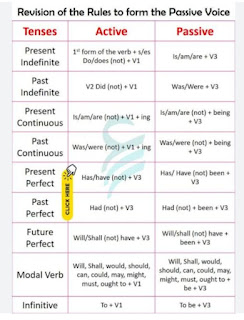Hello, I am Himanshi Parmar. This blog I have written as a part of teaching. The blog was written to provide study materials to my students. In this blog, i am going to discuss about 'Voices' (Active and Passive Voice). The blog includes following sub points -
- What is Voice of a verb?
- Types of Voices of Verb
- Rules/Process of Active – Passive Voice Conversions
- Examples of Active – Passive Voice Conversions
- Advantages of Passive Construction
- Disadvantages of Passive Construction
What is Voice of a verb?
The voice of a verb expresses whether the subject in the sentence has performed or received the action.
Example:
Active : The watchman opens the door.
Passive : The door is opened by the watchman.
Types of Voices of Verb
Verbs have two voices (i) Active Voice (ii) Passive Voice
1] Active Voice – When an action performed by the subject is expressed by the verb, it is an active voice. Active voice is used when more straightforward relation and clarity is required between the subject and the verb.
Active Voice example:
Hens lay eggs.
Birds build nests.
2] Passive Voice – When the action expressed by the verb is received by the subject, it is passive voice. Passive voice is used when the doer of the action is not known and the focus of the sentence is on the action and not the subject.
Passive Voice Examples:
Eggs are laid by hens.
Nests are built by birds.
Rules for Active – Passive Voice Conversions
1] Identify the subject, verb, and object in the active voice sentence.
2] If the object of the active voice sentence is more important than the subject, consider converting to passive voice.
3] Change the object of the active voice sentence into the subject of the passive voice sentence.
4] Use the appropriate form of the verb "to be" (am, is, are, was, were) based on the tense of the active sentence.
5] Use the past participle form of the main verb as the main verb in the passive sentence.
6] Optionally, include the agent (the doer of the action) in the passive sentence using "by" if it is necessary or adds clarity.
The rules to form the passive voice in various tenses
Examples of Active – Passive Voice Conversions
Active: "The chef prepared a delicious meal."
Passive: "The delicious meal was prepared by the chef."
Active: "They are painting the house."
Passive: "The house is being painted by them."
Active: "She will bake a cake."
Passive: "A cake will be baked by her."
Active: "The company awarded him the contract."
Passive: "He was awarded the contract by the company."
Active: "Someone stole my bicycle.”
Passive: "My bicycle was stolen by someone.”
Advantages of Passive Construction
1] Emphasis on Action: Passive construction puts the focus on what is done rather than who does it. This can be useful when the action is more important than the doer.
2] Hiding the Doer: Sometimes, we don't want to mention who did something. Passive voice lets us keep the doer a secret or mention them indirectly.
3] Formal Writing: In formal writing, like in reports or academic papers, passive voice is common. It adds a tone of seriousness and professionalism.
Disadvantages of Passive Construction
1] Not Always Clear: Passive sentences can sometimes be confusing. It's not always clear who did the action unless we mention it explicitly.
2] More Words: Passive sentences are often longer than active sentences. This can make writing seem wordy or less straightforward.
3] Less Engaging: Passive voice can make writing less interesting because it doesn't show action directly. Active voice is usually more engaging and lively.
Watch this video for better understanding.
References



.png)



Very well 😇
ReplyDelete